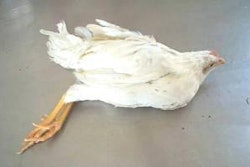The production of organic eggs administered by the USDA-National Organic Program has shown double digit increases in sales from inception of the program through to the onset of the recession. Although there are indications of improvement in sales volume, the favorable trend may be altered by a radical revision of the ground rules for production.
When the NOP was established, the architects of the system failed to envision the commercial-scale production which developed in response to demand. Investment of capital of up to $18/hen for in-line complexes fitted with aviaries took place. This was coupled with intensive production technology, packing and distribution of organic eggs to stock supermarkets shelves throughout the nation.
The Cornucopia Institute is currently heading the movement by organic “purists” to restrict commercial-scale production by focusing on the aspect of “outside access.” A number of spurious claims have been made concerning the alleged superior nutritional quality of eggs derived from hens allowed access to pasture. In contrast scientific evaluation has failed to show any quantifiable benefits. Poultry health specialists have highlighted the dangers of outside access with respect to exposure to viral infections such as avian influenza, Newcastle disease carried by wild birds especially on farms located in flyways used by migratory water fowl. Experience in Europe has shown that outside access is associated with a number of bacterial infections including salmonellosis, erysipelas and pasteurellosis. These diseases together with endoparasites cannot be treated or prevented using acceptable therapeutic modalities as a result of restrictions imposed in terms of the NOP.
It is obviously that it is the intent of the Cornucopia Institute and QAI, a certifying agency, to convince the respective committee of the NOP to impose an outside access requirement of between 1 and 2 sq. ft./hen. This would effectively disqualify all the in-line complexes with a current capacity of up to 500,000 hens to market product under the “USDA-Certified Organic” seal.
The net result of the inevitable restriction will be a marked decline in supply of USDA organic-certified eggs. This will be reflected in a sharp increase in price with the current retail $4 per dozen escalating to $7 per dozen based on supply demand disequilibrium and added production cost. The differential will affectively destroy the organic egg market to the ultimate detriment to the small-scale producers who consider that a more restrictive organic production program would be to their advantage.
The large supermarket chains that represent the bulk of distribution and sales will not be able to obtain sufficient product from small-scale production and they most certainly do not wish to assign shelf space to slow-moving, high-priced eggs.
Given the investment in in-line aviary complexes, the commercial-scale producers will develop their own “organic fed” product. These hens will be fed diets compounded from organic grains and will conform to the “free of pesticides” claim. Since there is no scientific reason to exclude synthetic methionine and lysine from diets, due to the reality that these nutrients are derived from bacterial fermentation using non-GMO organisms, the new category will be produced at a lower cost than conventional organic product. Given the competitive situation in the U.S. egg industry these savings will be passed onto consumers and will contribute to increased consumption and hence production of the new category.
The commercial sector of organic egg production will generate consumer confidence and retailer support by publicizing realistic health, safety and production standards, implementing an audit program to ensure compliance and promoting the product which will not bear the USDA-organic seal. The reduced volume of production of USDA-certified organic eggs produced in accordance with anticipated NOP requirements will represent a small share of the market and will in all probability are restricted to the boutique supermarkets and stores specializing in high-priced food products purchased by an affluent clientele.
The bottom line is that the organic producers in pursuing their objective of stifling competition by moving the goal posts are effectively sowing the seeds of their own demise.
A more pragmatic approach would be to coexist with large-scale producers by establishing distinct categories of organic-certified eggs derived from free-roaming flocks which are confined to barns with sun porches and flocks which are allowed to range on pasture or are provided with extensive outside access. This would provide consumers with a choice according to their perceptions and willingness to pay.


















